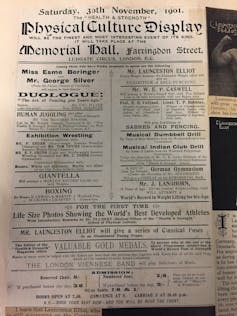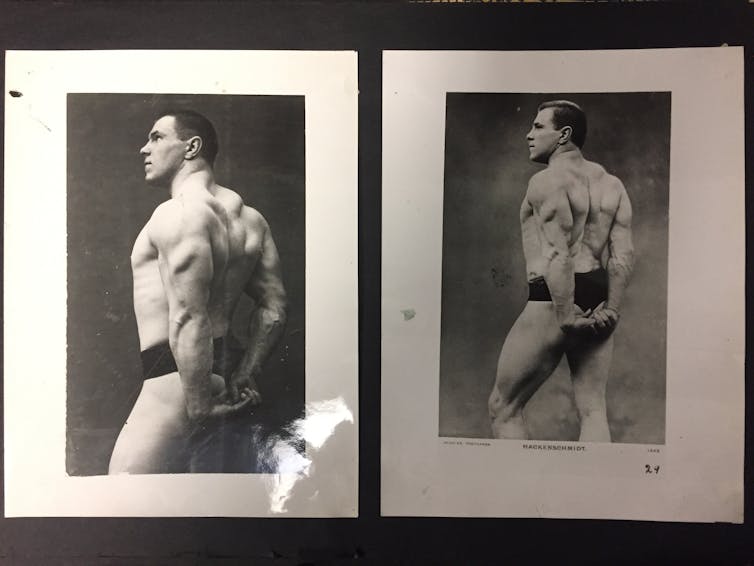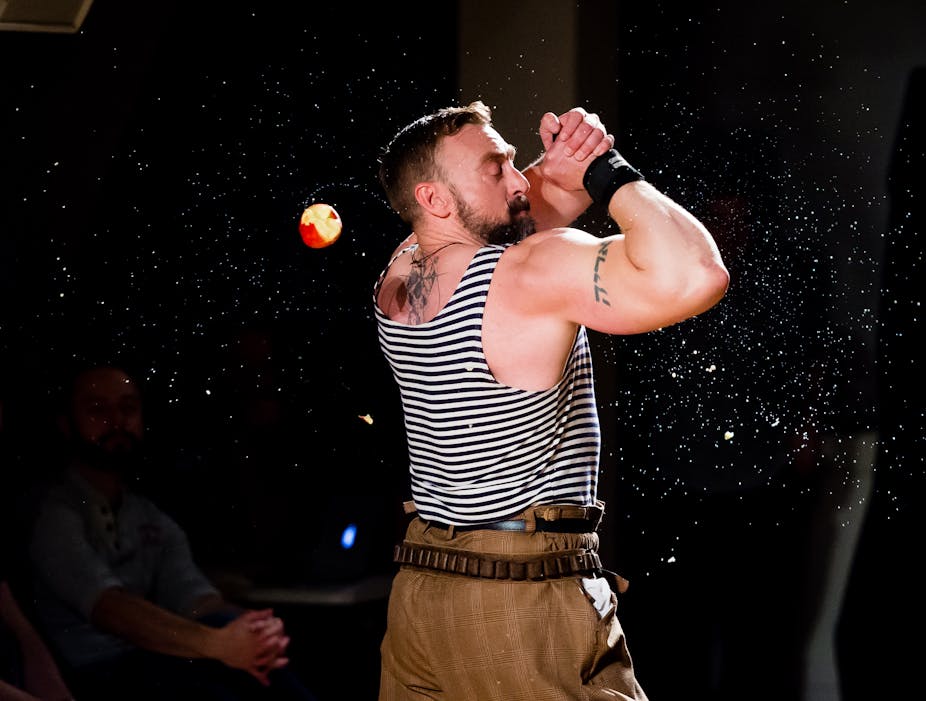It has never been more urgent to discuss what it is to “be a man”. As the poet Austin Allen says: “no one is happy with the conventions of masculinity, least of all the men who strictly obey them.”
The fit, muscular, athletic body has been a long-held manly convention. But living up to this ideal can be destructive – there is evidence of increased use of anabolic steroids by young men, and gym-goers are considered narcissistic and self-obsessed. Muscular men are apparently less likely to support social and economic equality, yet muscle-bound masculinity is still everywhere from superhero films to advertising.
Should we throw away gym culture with those “toxic” aspects of masculinity that desperately need to go? This risks also discarding the positive benefits of men’s fitness. I propose instead that we reassess the meaning of the ideal muscular male body, by looking back at the unlikely place where it was born: the 19th-century popular theatre.
Fitness and fakery

Men’s fitness training was invented and popularised by the popular music hall entertainment tradition of the 19th and early 20th century. “Physical culture” performances ranged from weightlifting displays at local clubs to vaudeville strongman shows. Some performers were huge celebrities - for example, the bodybuilder Eugen Sandow. They used these theatrical shows to spread their message of ideal health, fitness and manliness.
The great bodybuilder and strongman George Hackenschmidt (1896-1968) reinvented himself through the theatre. He was an apprentice blacksmith in Dorpat (now Tartu), Estonia, when he was discovered and became “The Russian Lion”, performing feats of strength and wrestling in theatres across Europe. Eventually, he settled in London, and became one of theatre impresario CB Cochran’s best-known acts.
Hackenschmidt was deeply conflicted about his life in the theatre. In his unpublished autobiography, he sneers at other strongmen and their “swagger, showmanship, or theatrical manner”, claiming the most eye-catching feats were mostly “slight of hand”. While he posed for physique photos like other bodybuilders, Hackenschmidt stated that his muscles resulted from his “natural” strength, and maintained that he never fixed or deliberately threw a match.
After retiring Hackenschmidt took up philosophy, lecturing at Columbia University and Trinity College, Cambridge, and published several books. His philosophy is concerned with authenticity, and how to live freely and truthfully. Not surprisingly, actors were his example of how not to live: “They do not represent their own, individual qualities and attributes”, he wrote in an unpublished essay, “because of their great degeneration […] they are particularly well suited for pretence and deception.”
Hackenschmidt’s hatred of theatre – even though it made his name – is similar to why the theatrical history of men’s fitness is a mere footnote today. Historically, theatre has been maligned and even hated for its association with deceit, fakery and excess. Hackenschmidt, like other physical culturists, was trying to show his audiences how to be a man (his first book is even called The Way to Live). But if physical culture came from the theatre then the manly ideal it built seems like not just “acting”, but bad acting.

Performing masculinity
As much as the physical culture movement might wish to forget its association with theatre, it presents an opportunity to think differently about being a man. On the surface, thinking about a “theatrical” nature of masculinity sounds like American philosopher Judith Butler’s theory of gender performativity: Butler saw gender as the socially constructed set of behaviours in everyday life that define and comply with social norms.
But “theatre” does not just mean “performance.” Being theatrical implies a conscious attempt to convince an audience to suspend its disbelief in something that is not real, rather than unconscious compliance to social norms. Things like props and costume are employed to help. But the attempt to convince often fails, even (or especially) when it’s trying hardest.
“Posing” and “showing off” is usually seen in a negative light. But seeing fitness culture as a theatrical performance of gender demonstrates that the ideal of the strong, muscular, athletic male is not natural but socially constructed, as are the values we attach to it. While the muscular male body sometimes symbolises military power, national strength, and aggression (as in Nazi Germany), a bodybuilder on stage poses for the attention of the audience, whose validation can produce other meanings. Extreme theatrical expressions of men’s fitness, such as bodybuilding or strongman contests, are therefore not unlike drag – a performance that Butler would argue exposes the degree to which gender is culturally scripted. Only in this case, it’s men playing at being men.
So presenting manly ideals on a stage as entertainment exposes them as cultural scripts rather than as an expression of some authentic “toxic masculinity”. I believe that by presenting them in their original context as entertainment these scripts are robbed of their power – and with this in mind I recently directed the Dynamic Tensions Physical Culture Show at Kings College London’s Anatomy Museum.
Featuring performers with an athletic background (strongman, bodybuilding, wrestling, rugby and weightlifting), the performance staged “masculine acts” of physical culture, while emphasising other subtexts such as injury, ageing and friendship. It aimed to present a different perspective on bodies that often signify aggression, violence and narcissism. While theatre strongmen, bodybuilders and wrestlers may be responsible for the physical ideal associated with a masculinity that desperately needs to change, remembering their theatrical origins helps us see past the stereotype.
Physical culture can have many positive effects (aside from health), like building friendship and community among people who might not otherwise meet. Gyms used to scare me, but they are not so different from the theatre stages and rehearsal spaces where I found community in my youth. Like theatres, gyms are full of people working on presenting something to the world, each with a different motivation and story.


